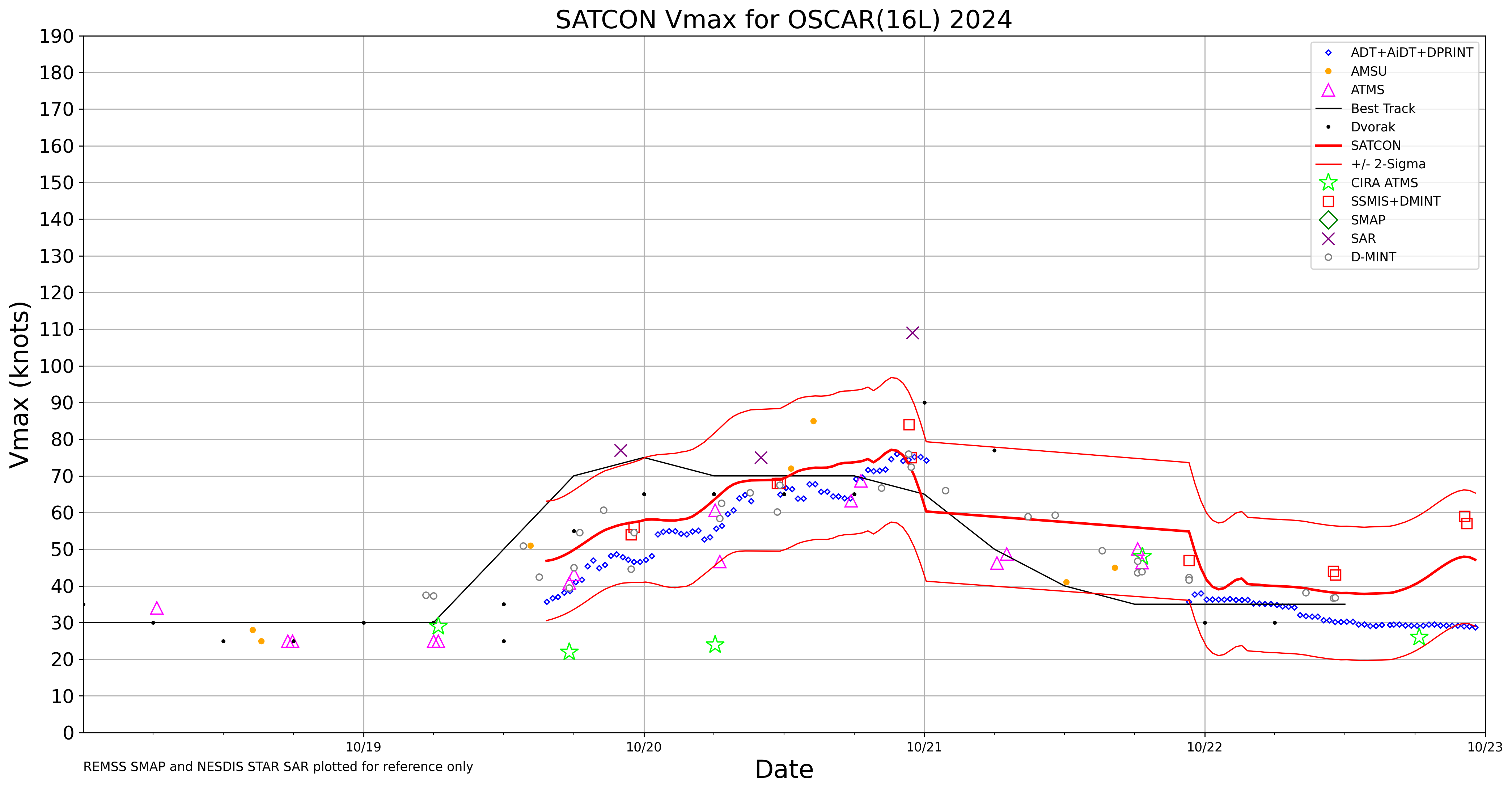Hurricane Rafael Discussion Number 10
NWS National Hurricane Center Miami FL AL182024
1000 PM EST Tue Nov 05 2024
We have been fortunate to receive an abundance of in-situ data from
both an Air Force Reserve C-130 and a NOAA-P3 Hurricane Hunter
aircraft tonight. Their data indicated that Rafael had become a
hurricane just after 00 UTC with peak 750 mb flight level winds of
79 kt from the NOAA-P3 and 700 mb winds of 73 kt from the Air Force
C-130. On satellite imagery Rafael's structure continues to improve
with very cold deep convection near the center rotating around the
center. Radar reflectivity out of Grand Cayman Island also shows the
inner core continues to improve with a 10-15 n mi diameter eyewall,
though is still occasionally open on the southwest side. The initial
intensity is set to 70 kt, based on NOAA-P3 Tail Doppler Radar
velocities up to 85 kt in the NE eyewall boundary layer, which was
matched by an Air Force Recon dropsonde also launched in the NE
eyewall at 0025 UTC that had a 500 m layer average wind of 85 kt.
Rafael continues to move northwestward at 320/11 kt. A prominent
low- to mid-level ridge centered offshore of the Southeastern U.S.
should continue to steer the hurricane northwestward for the next
day or so. This track will lead to Rafael moving through the Cayman
Islands for the next few hours and then across the western portion
of Cuba during the afternoon on Wednesday. Thereafter, Rafael will
emerge into the southeastern Gulf of Mexico, where it is becoming
increasingly likely that the aforementioned ridging will begin to
build to the north of Rafael, leading to the hurricane turning more
west-northwestward and slowing down as it moves into the central
Gulf of Mexico. There have been notable changes in the global model
guidance today, with the GFS track shifting significantly to the
south and west over the past four cycles, closer to the ECMWF track.
This evolution is likely partially related to changes in the
upstream synoptic flow pattern, now showing a cutoff low digging
into the four corners region rather than being more progressive
moving eastward in the Great Plains. Such an evolution will allow a
narrow ridge to become oriented directly over Rafael, substantially
slowing its forward motion. Because it is becoming more evident the
ECMWF synoptic flow pattern may end up being correct, the NHC track
has been shifted leftward, especially beyond 48 h, compared to the
previous forecast track. At the very end of the forecast, Rafael
will likely become a shallow cyclone, drifting slowly northward in
the low-level flow.
Environmental conditions are very favorable for continued
intensification, and given that Rafael now possesses a tight inner
core and eyewall, rapid intensification seems likely. Strangely, the
HAFS models did not appear to initialize correctly at 18 UTC, and
were a good 5-10 mb too weak at 00 UTC tonight. Despite this, HAFS-B
raw model output shows Rafael becoming a category 2 hurricane before
moving over Cuba, and the NHC intensity forecast will now show
Rafael becoming a Category 2 hurricane in 12 h. It is also not
impossible Rafael becomes a major hurricane before impacting Cuba,
with at least one hurricane-regional model showing this possibility
this cycle (HMON). Rafael should briefly weaken over Cuba. After the
hurricane emerges into the Gulf of Mexico, the environment is not as
favorable as the northwestern Caribbean, but is also not especially
unfavorable from 24-48 h as it will remain over 27-28 C waters, and
only 10-15 kt of vertical wind shear. However, mid-level shear
begins to substantially increase after that time, and sea-surface
temperatures from wave drifters just north of Rafael's forecast
track are only 26-27 C. This one two negative punch will likely
begin to result in weakening, which should become more rapid towards
the end of the forecast period as very dry air over the western Gulf
of Mexico is likely to be ingested into the storm. The NHC intensity
forecast is at the upper-end of the guidance in the first 12 h, but
then falls closer to the HCCA consensus aid between 24-48 h, before
dropping into the middle of the intensity guidance envelope by the
end of the forecast. Rafael might be close to becoming post-tropical
as global model guidance suggests it may lose most of its remaining
convection in about 120 h.
Key Messages:
1. Rafael is forecast to be a hurricane when it passes near or over
the Cayman Islands during the next 12 hours, where damaging
hurricane-force winds, a dangerous storm surge, and destructive
waves are expected. Additional strengthening is expected before
Rafael reaches western Cuba and the Isle of Youth on Wednesday. A
hurricane warning is in effect for this region, where damaging
hurricane-force winds, life-threatening storm surge, and destructive
waves are also expected.
2. Tropical storm conditions are expected in the Lower and Middle
Florida Keys beginning Wednesday and Wednesday night.
3. It is too soon to determine what, if any, impacts Rafael could
bring to portions of the northern Gulf Coast. Residents in this
area should regularly monitor updates to the forecast.
4. Rafael will bring areas of heavy rain across portions of the
western Caribbean through early Thursday, including Jamaica and the
Cayman Islands, along with southern and western portions of Cuba.
Flash flooding and mudslides are possible along the higher terrain
in Jamaica and Cuba.
FORECAST POSITIONS AND MAX WINDS
INIT 06/0300Z 19.7N 80.4W 70 KT 80 MPH
12H 06/1200Z 21.2N 81.5W 90 KT 105 MPH
24H 07/0000Z 23.0N 83.2W 80 KT 90 MPH...ON THE N CUBA COAST
36H 07/1200Z 24.3N 84.6W 85 KT 100 MPH
48H 08/0000Z 24.8N 85.9W 85 KT 100 MPH
60H 08/1200Z 25.1N 87.4W 80 KT 90 MPH
72H 09/0000Z 25.4N 89.0W 75 KT 85 MPH
96H 10/0000Z 26.7N 91.2W 55 KT 65 MPH
120H 11/0000Z 27.9N 91.6W 35 KT 40 MPH
$$
Forecaster Papin






